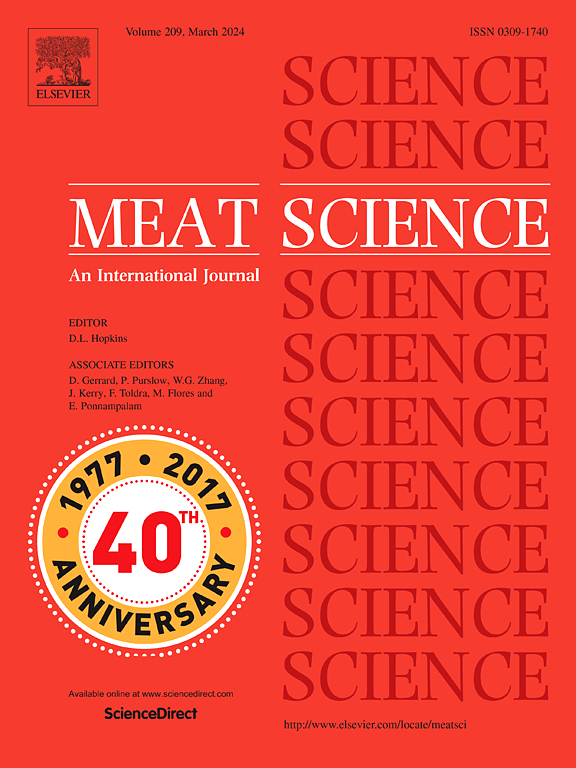控制肉类行业沙门氏菌的创新方法
IF 7.1
1区 农林科学
Q1 Agricultural and Biological Sciences
引用次数: 0
摘要
沙门氏菌是肠杆菌科的一种革兰氏阴性棒状杆菌,是导致人类和动物疾病的重要原因。它寄生在牲畜、家禽和其他温血动物的消化道中,并可通过粪便污染各种环境和食物。肠炎沙门氏菌是影响人类的主要菌种,广泛存在于牛、猪和家禽中。尽管努力控制肉类系统中的病原体,但美国每年仍发生 140 多万例人类沙门氏菌病,其中肠炎沙门氏菌和鼠伤寒沙门氏菌是主要的血清型。肉类加工技术的进步已经在多个阶段减少了病原体,但要对公众健康产生实质性影响,还需要更多的创新方法。本文讨论了最大限度减少食品供应中沙门氏菌的当前和未来战略。它通过对整个加工链进行生物测定,强调收获前和收获后沙门氏菌的流行情况,重点关注牛肉和猪肉的干预措施,如益生菌。这些干预措施有望减少牛粪和淋巴结中的病原体负荷。微生物组、全基因组测序(WGS)和电子显微镜(EM)等技术可详细了解沙门氏菌的遗传和细菌结构形态特征,有助于制定有针对性的干预措施。将快速检测、生物绘图和环境绘图结合起来,可以加强肉类生产中的病原体追踪,降低沙门氏菌的流行率,改善风险评估和食品安全。先进、最新和创新的技术可以及时识别病原体,提供详细的空间和定量数据,并采取更有效的干预措施。这样就能生产出更安全的食品,减少食源性疾病。本文章由计算机程序翻译,如有差异,请以英文原文为准。
Innovative approaches to controlling Salmonella in the meat industry
Salmonella, a Gram-negative, rod-shaped bacterium from the Enterobacteriaceae family, is a significant cause of illnesses in humans and animals. It resides in the digestive tracts of livestock, poultry, and other warm-blooded animals and can contaminate various environments and foods through fecal matter. Salmonella enterica, the main species that affects humans, is widespread in cattle, pigs, and poultry. Despite efforts to control pathogens in meat systems, over 1.4 million human salmonellosis cases occur annually in the U.S., with serotypes S. enteritidis and S. typhimurium being predominant. Advances in meat processing have targeted pathogen reduction at multiple stages, but more innovative approaches are needed for substantial public health impact. This paper discusses current and future strategies to minimize Salmonella in the food supply. It emphasizes pre- and post-harvest Salmonella prevalence by biomapping it through the whole processing chain, focusing on beef and pork interventions such as probiotics. These interventions have shown promise in reducing pathogen loads in cattle manure and lymph nodes. Techniques such as microbiome, whole genome sequencing (WGS), and electron microscopy (EM) provide detailed insights into Salmonella's genetic and bacterial structural-morphological characteristics, aiding in the development of targeted interventions. Integrating rapid detection, biomapping, and enviromapping enhances pathogen tracking in meat production, reducing Salmonella prevalence and improving risk assessment and food safety. The advanced, current, and innovative techniques allow for timely identification, detailed spatial and quantitative data, and more effective interventions. This leads to safer food products and reduces foodborne illnesses.
求助全文
通过发布文献求助,成功后即可免费获取论文全文。
去求助
来源期刊

Meat Science
工程技术-食品科技
CiteScore
12.60
自引率
9.90%
发文量
282
审稿时长
60 days
期刊介绍:
The aim of Meat Science is to serve as a suitable platform for the dissemination of interdisciplinary and international knowledge on all factors influencing the properties of meat. While the journal primarily focuses on the flesh of mammals, contributions related to poultry will be considered if they enhance the overall understanding of the relationship between muscle nature and meat quality post mortem. Additionally, papers on large birds (e.g., emus, ostriches) as well as wild-captured mammals and crocodiles will be welcomed.
 求助内容:
求助内容: 应助结果提醒方式:
应助结果提醒方式:


